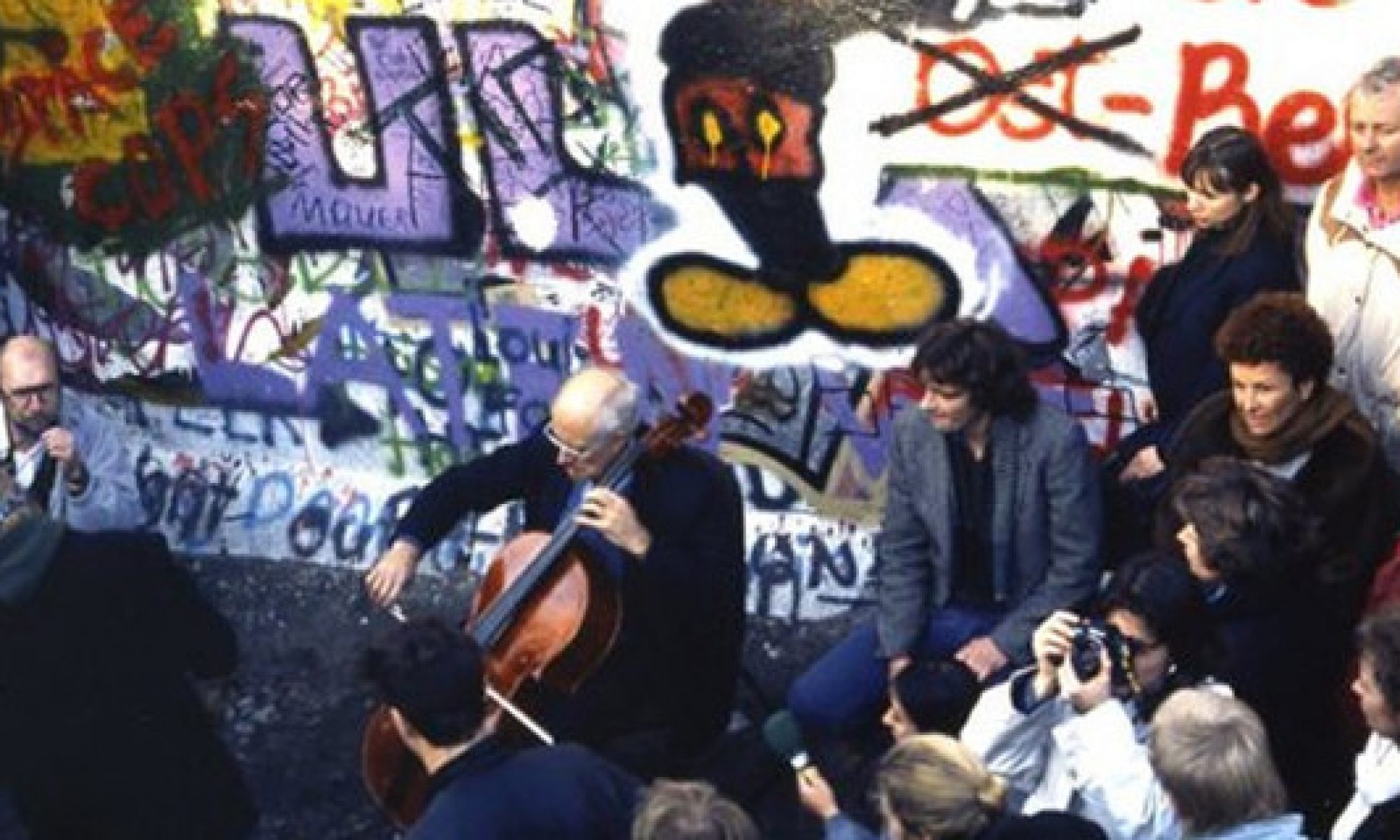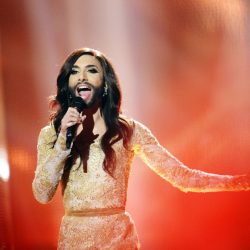Background
The Nazi era in Germany followed the period known as the Weimar Republic. During this time Adolf Hitler rose to power as he capitalized on the economic distress that Germany faced after World War Ⅰ [1]. The Nazi era is a period that we often gloss over, especially in terms of artistic expression because many historians think that delving deeper into this topic will just lead to controversy [2]. However, I think that children’s music during this time is important to analyze because it shows us how music can be used to push a political agenda.
Music of the Hitler Youth
The Hitler-Jugend, Bund deutscher Arbeiterjugend or Hitler Youth was created on July 4, 1926, although there were other groups that preceded this one beginning in 1922[3]. This group was created to indoctrinate German youth and instill them with the Nazi ideology. Hitler speaks about the goals of the Hitler Youth in this quote stating that “These boys and girls enter our organizations [at] ten years of age, and often for the first time get a little fresh air; after four years of the Young Folk they go on to the Hitler Youth, where we have them for another four years . . . And even if they are still not complete National Socialists, they go to Labor Service and are smoothed out there for another six, seven months . . . And whatever class consciousness or social status might still be left . . . the Wehrmacht [German armed forces] will take care of that,” and here you can clearly see that he uses the Hitler youth as a way to produce future Nazi party members and soldiers[4]. To achieve this goal the Nazi party often tried to appeal to children through music and literature because children can easily be taught prejudice through these methods [5]. This claim is backed by an internal memo from the Hitler Youth organization in which it states, regarding music, that “ during celebrations and singing events [that] we have an excellent opportunity to have a political effect wide beyond the typical formation … Songs possess the strongest community-building power. Thus, we use them deliberately at those moments when we want to awaken the consciousness of being part of a community, in order to deepen the power of such an experience,” [6]. The Hitler Youth were also given music lessons so that they could learn to play instruments and improve their vocal abilities [7]. The Hitler Youth were encouraged to perform as groups for prominent Nazi leaders and larger Nazi party events. This type of group performance was believed to instill the value of the power that the Nazi party had as a group rather than people thinking about their individualized goals [8]. Each song that they sang included propaganda messages that supported the Nazi ideals, and was used to systematically give the Hilter Youth an idealized version of Germany and Hitler’s anti-Semitic views. While this approach to the use of music for political gain is not new, as similar uses of music appeared in the Soviet Union and the Weimar Republic, the Nazi regime is unique in the fact that is reached such a large scale. By the year 1945 almost every boy in Nazi Germany, excluding Jewish boys and other people under the attack of the Nazis, was a part of the Hitler Youth and hundreds of thousands of young girls were in the Bund Deutscher Mädel or League of German Girls[9]. One previous member of the Hitler Youth recalls his time in the program. He states “in the songs that we sang, in the poems that we recited, everything was bright, shiny and clean, the sun and earth were ours, and tomorrow so, too, would be the whole world[10].
“Es Zittern die Morschen Knochen” (“The Rotten Bones Are Trembling”) by Hans Baumann
This song by Hans Baumann was one of the anthems of the Hitler Youth, and it is the same song that the former Hitler Youth member above was remembering. The song’s lyrics are portraying Germany as a powerful world force, and it’s telling everyone that people underestimated Germany after World War Ⅰbut they won’t be underestimated again. When listening to the song it sounds triumphant and reminiscent of a war march. Also similar to the song Life is Better Now from the Soviet Union it is repetitive so that people can easily sing it, and it is cheery.
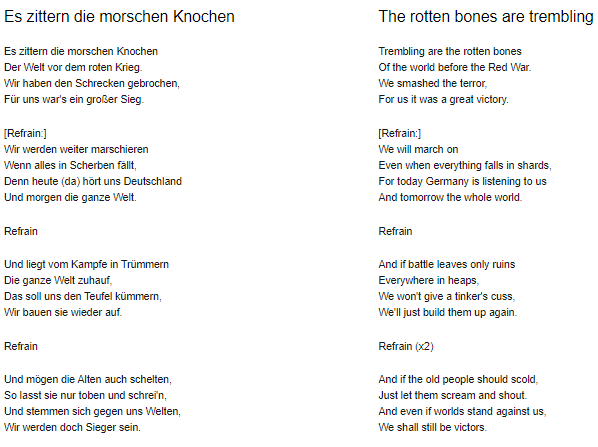
“Vorwärts! Vorwärts! Schmettern die Hellen Fanfaren” (“Forward! Forward! Blare the Bright Fanfares”)
“Vorwärts! Vorwärts! Schmettern die Hellen Fanfaren” is another one of the Hitler Youth marching songs. It is again very uplifting, and cherub-like. In this song, the boys of the Hitler Youth are shouting to the world that they are the future of Germany and that they will fight for their Fuhrer. This song focuses more on the allegiance to the Nazi party and the duties of the Hitler Youth specifically.
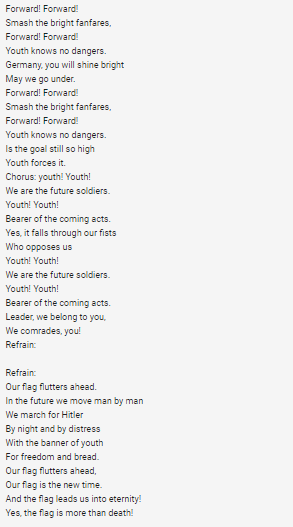
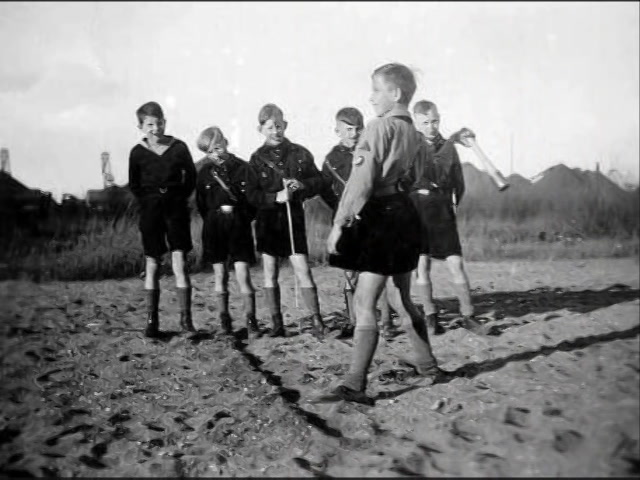
Brundibár
Brundibár is a children’s opera written in 1938 by a Czech-Jewish composer named Hans Krasa[11]. While the opera was written entirely for children to perform, it had an underlying political message about defeating a villainous tyrant that resonated with all the Jewish members of the Nazi created ghettos[12]. Though the opera was well-received, it is where it was performed that makes it special. Due to the German takeover of Czechoslovakia Hans Krasa never got to enter Brundibár into its intended competition, so he decided to put on the performance at the Jewish Orphanage in Prague[13]. During the preparations for the performance the director of the production, a Jewish man named Rafael Schächter, and Krasa were both deported[14]. Even with all the complications, the performance brought joy to the children of the orphanage. After the production, all of those involved in the performance of the opera was deported to the Terezin ghetto[15]. In the ghetto, many composers, artists, and writers still created art to make the beatings and awful conditions of the ghetto more tolerable[16]. I felt that this opera should be included in the discussion of German children’s music because it shows that while music was used by Hitler and the Nazi party to promote their political ideals during this era, it was also used by the people being oppressed by the regime. This opera, in particular, appealed to the children in the ghetto who faced terrible disparities and spread their message of hope that their suffering would end.
Sources:
[1] History.com Editors. “Adolf Hitler.” History.com. A&E Television Networks, October 29, 2009. https://www.history.com/topics/world-war-ii/adolf-hitler-1.
[2] Pamela M. Potter. “What Is ‘Nazi Music’?” The Musical Quarterly 88, no. 3 (2005): 428. http://search.ebscohost.com/login.aspx?direct=true&db=edsjsr&AN=edsjsr.4123231&site=eds-live
[3]Koch, H. W. The Hitler Youth : Origins and Development 1922-1945. Vol. 1st Cooper Square Press ed. New York: Cooper Square Press, 2000. http://search.ebscohost.com/login.aspx?direct=true&db=nlebk&AN=505991&site=eds-live.
[4]United States Holocaust Memorial Museum. United States Holocaust Memorial Museum. Accessed October 16, 2019. https://encyclopedia.ushmm.org/content/en/article/indoctrinating-youth.
[5]Wecker, Menachem. “How the Nazis ‘Normalized’ Anti-Semitism by Appealing to Children.” Smithsonian.com. Smithsonian Institution, June 27, 2016. https://www.smithsonianmag.com/history/how-nazi-normalized-anti-semitism-appealing-children-180959539/.
[6]ORT, World. “Music and the Holocaust.” Music and the Holocaust: Music amongst the Hitler Youth. Accessed October 16, 2019. http://holocaustmusic.ort.org/politics-and-propaganda/third-reich/music-hitler-youth/.
[7] Ibid.
[8]ORT, World. “Music and the Holocaust.” Music and the Holocaust: Music amongst the Hitler Youth. Accessed October 16, 2019. http://holocaustmusic.ort.org/politics-and-propaganda/third-reich/music-hitler-youth/.
[9]Ibid.
[10]ORT, World. “Music and the Holocaust.” Music and the Holocaust: Music amongst the Hitler Youth. Accessed October 16, 2019.
[11]Lee, Alexander. “THE MUSIC OF TIME NO 12: A LIGHT IN THE DARKNESS: A Children’s Opera Brought a Brief Respite from the Terrors of the Holocaust.” History Today 68, no. 6 (June 2018): 86–88. http://search.ebscohost.com/login.aspx?direct=true&db=khh&AN=129552253&site=eds-live.
[12]ORT, World. “Music and the Holocaust.” Music and the Holocaust: Brundibár. Accessed October 17, 2019. http://holocaustmusic.ort.org/places/theresienstadt/brundibar/.
[13]Lee, Alexander. “THE MUSIC OF TIME NO 12: A LIGHT IN THE DARKNESS: A Children’s Opera Brought a Brief Respite from the Terrors of the Holocaust.” History Today 68, no. 6 (June 2018): 86–88.
[14] Ibid.
[15]Lee, Alexander. “THE MUSIC OF TIME NO 12: A LIGHT IN THE DARKNESS: A Children’s Opera Brought a Brief Respite from the Terrors of the Holocaust.” History Today 68, no. 6 (June 2018): 86–88.
[16]Ibid.
